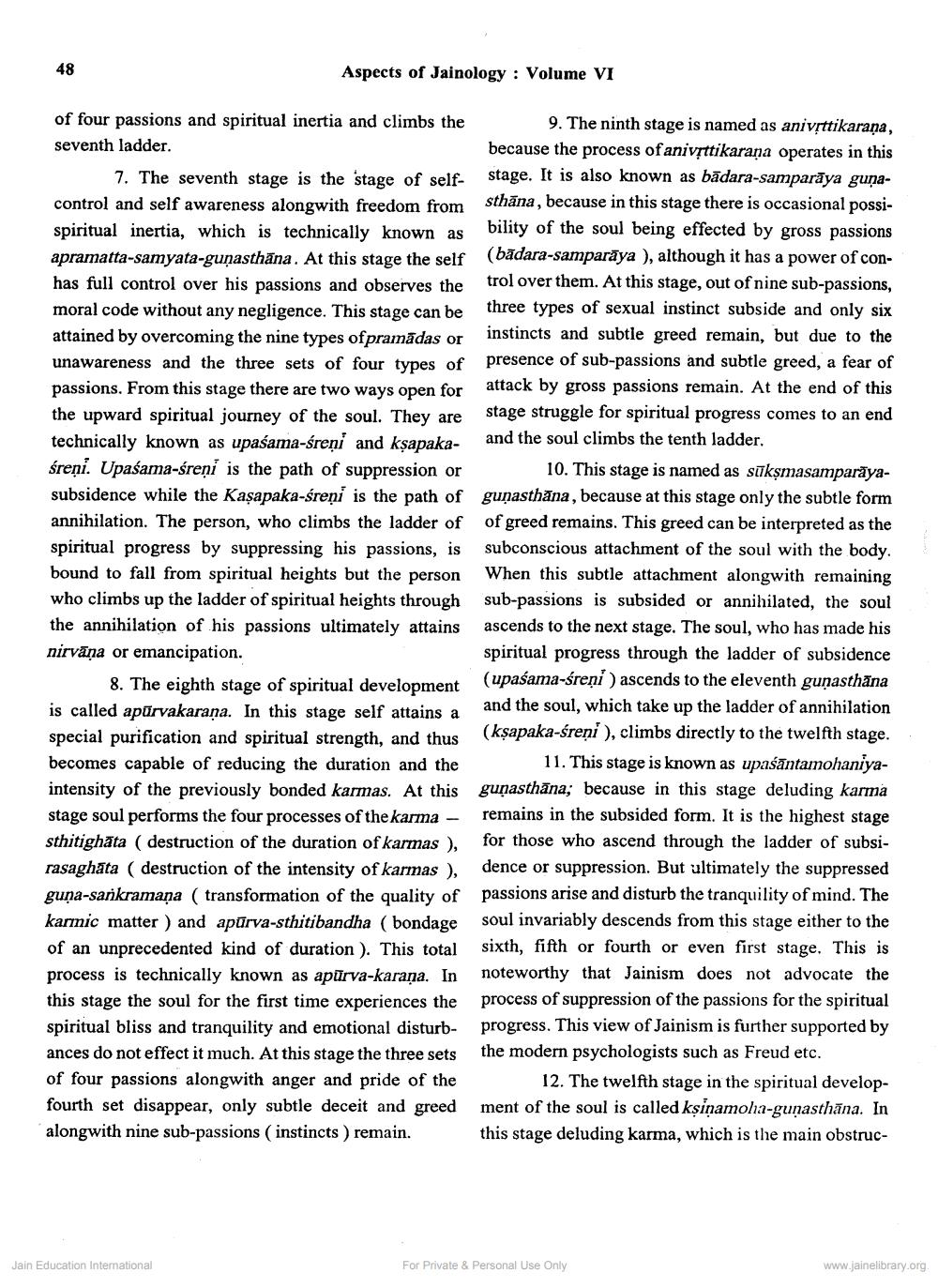________________
48
Aspects of Jainology: Volume VI
of four passions and spiritual inertia and climbs the seventh ladder.
7. The seventh stage is the stage of selfcontrol and self awareness alongwith freedom from spiritual inertia, which is technically known as apramatta-samyata-guṇasthāna. At this stage the self has full control over his passions and observes the moral code without any negligence. This stage can be attained by overcoming the nine types of pramädas or unawareness and the three sets of four types of passions. From this stage there are two ways open for the upward spiritual journey of the soul. They are technically known as upasama-śreņi and kṣapakaśreņi. Upasama-śreņi is the path of suppression or subsidence while the Kasapaka-srepi is the path of annihilation. The person, who climbs the ladder of spiritual progress by suppressing his passions, is bound to fall from spiritual heights but the person who climbs up the ladder of spiritual heights through the annihilation of his passions ultimately attains nirvana or emancipation.
8. The eighth stage of spiritual development is called aparvakarana. In this stage self attains a special purification and spiritual strength, and thus becomes capable of reducing the duration and the intensity of the previously bonded karmas. At this stage soul performs the four processes of the karma sthitighata (destruction of the duration of karmas), rasaghata (destruction of the intensity of karmas), guna-sankramana (transformation of the quality of karmic matter) and apūrva-sthitibandha (bondage of an unprecedented kind of duration). This total process is technically known as aparva-karaṇa. In this stage the soul for the first time experiences the spiritual bliss and tranquility and emotional disturbances do not effect it much. At this stage the three sets of four passions alongwith anger and pride of the fourth set disappear, only subtle deceit and greed alongwith nine sub-passions (instincts) remain.
Jain Education International
-
9. The ninth stage is named as anivṛttikaraṇa, because the process of anivṛttikarana operates in this stage. It is also known as badara-samparāya guṇasthāna, because in this stage there is occasional possibility of the soul being effected by gross passions (badara-samparāya ), although it has a power of control over them. At this stage, out of nine sub-passions, three types of sexual instinct subside and only six instincts and subtle greed remain, but due to the presence of sub-passions and subtle greed, a fear of attack by gross passions remain. At the end of this stage struggle for spiritual progress comes to an end and the soul climbs the tenth ladder.
10. This stage is named as silkṣmasamparayagunasthana, because at this stage only the subtle form of greed remains. This greed can be interpreted as the subconscious attachment of the soul with the body. When this subtle attachment alongwith remaining sub-passions is subsided or annihilated, the soul ascends to the next stage. The soul, who has made his spiritual progress through the ladder of subsidence (upasama-śreņi) ascends to the eleventh gunasthana and the soul, which take up the ladder of annihilation (kṣapaka-śreņi), climbs directly to the twelfth stage.
11. This stage is known as upasantamohaniyagunasthana; because in this stage deluding karma remains in the subsided form. It is the highest stage for those who ascend through the ladder of subsidence or suppression. But ultimately the suppressed passions arise and disturb the tranquility of mind. The soul invariably descends from this stage either to the sixth, fifth or fourth or even first stage. This is noteworthy that Jainism does not advocate the process of suppression of the passions for the spiritual progress. This view of Jainism is further supported by the modern psychologists such as Freud etc.
12. The twelfth stage in the spiritual development of the soul is called kṣinamoha-guṇasthāna. In this stage deluding karma, which is the main obstruc
For Private & Personal Use Only
www.jainelibrary.org.




